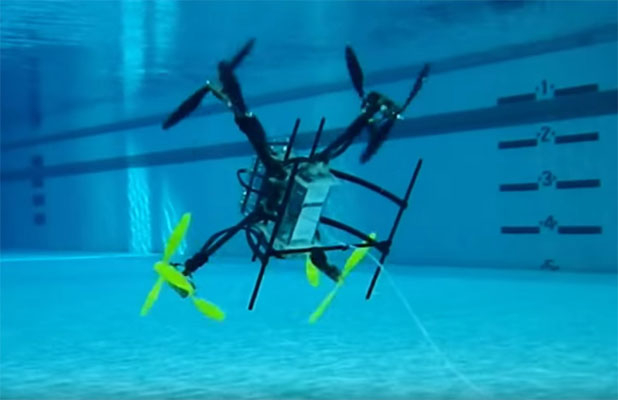Navy Funds Rutgers to Develop Drone Equally Adept at Flying and Swimming
One-of-a-kind vehicle could speed search and rescue, monitor oil spills, defuse underwater mine threats
The Office of Naval Research has awarded Rutgers University a grant to develop a drone – equally adept at flying through the air and navigating underwater – that could speed search-and-rescue operations, monitor the spread of oil spills and even help the Navy rapidly defuse threats from underwater mines.
Javier Diez, a professor in the Department of Mechanical and Aerospace Engineering, had been dabbling with the concept for years with the help of his graduate and undergraduate students. But when he demonstrated it to Navy research officials earlier this year, they almost immediately funded his work on new versions of the air-and-water craft.

“They told me they’d never seen anything like it,” said Diez, who at first compared the vehicle to what nature does.
“There are birds that dive into water and fish that fly,” he said.
But that comparison breaks down quickly.
“Waterfowl are still better at flying than swimming, and flying fish are still better at swimming than flying. Our device is equally adept at both,” he said. ”In a sense, we are defying nature rather than emulating it.”
Diez predicts many potential applications. For search and rescue, for instance, the vehicle could scan the water from above to locate missing swimmers and sailors, and upon spotting shipwreck debris could dip underwater to further examine the scene. At an oil spill site, it could map the spread of a spill and see how deep the plume reaches.
An air-and-water drone could also help engineers inspect underwater structures, such as bridge and dock piers, ship hulls and oil drilling platforms.
But what specifically makes the concept attractive to the funding agency – the R&D arm of the United States Navy – which awarded the $618,000 grant?
“Mines are probably the biggest problem for the Navy,” said Diez. “They need to map where mines are. Now there are a lot of false positives. This could be a better technology to rapidly investigate these potential threats.”
And in naval warfare, a fleet of drones could be stationed out of sight in an underwater base or on a submarine. The drones could emerge quickly from the depths, get a quick glimpse of enemy ship deployments, and then hide again.
Diez acknowledges that much work needs to be done. For example, the models that he and his students have demonstrated are tethered by a thin wire to a controller, as typical radio signals can’t penetrate the water. To cut the cord, engineers will study ways to control vehicles acoustically – with sound pulses instead of radio waves.
“By next summer, we plan to demonstrate a vehicle that can swim in a seawater environment and do complex manuvers,” he said. “At that point, we’ll start to outfit it with whatever sensors the Navy wants to have, such as cameras and sonar detectors.”
Media inquiries: Carla Cantor at ccantor@ucm.rutgers.edu or 848-932-0555.